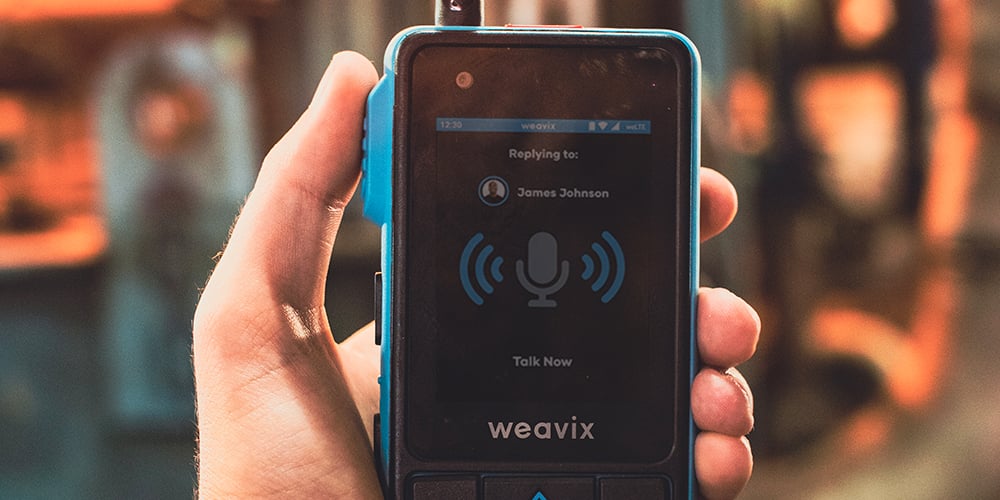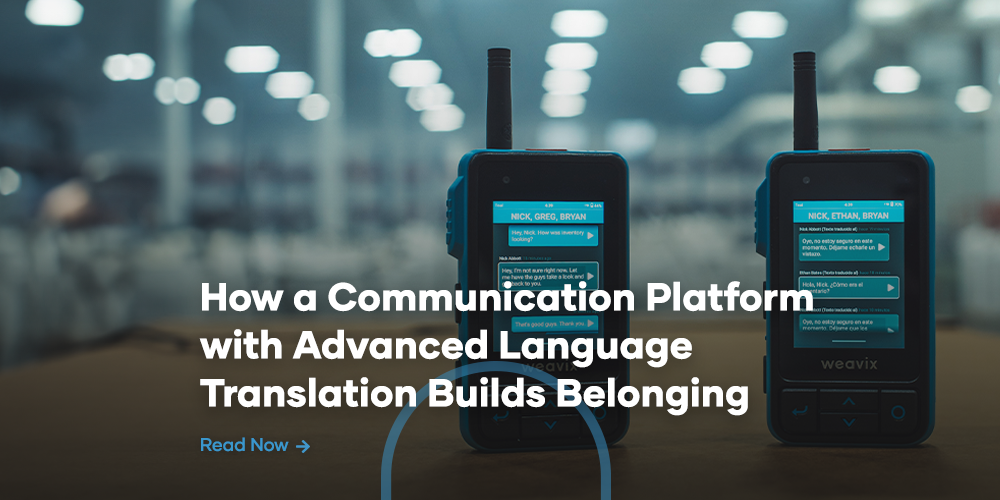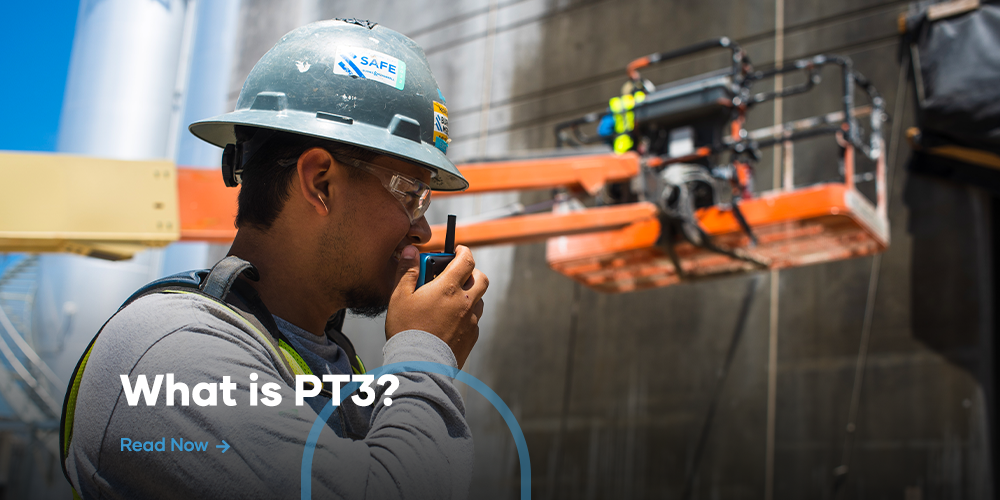Manufacturers were some of the earliest adopters of push-to-talk radios. From the technology’s introduction in the early 1900s, the manufacturing industry quickly noticed the impact expanding their communications had on improving productivity, managing their resources better and increasing revenue.
Now, push-to-talk technology is used in nearly any industry, giving deskless frontline workers near-instant access to their colleagues and the rest of their enterprise.
PTT radios continue to lead as the frontline’s preferred communication device. But as the available communication technologies and devices continue to grow steadily, we’ve noticed an increase in PTT apps. Rather than these solutions having a dedicated device, the intent is to use your and your worker’s personal and professional mobile phones instead of radios.
Modern advances and the introduction of a smart radio for manufacturing workers reinforce the continued need for push-to-talk radios in manufacturing that mobile phones can’t offer.
Communicating with Mobile Phones Isn’t Ideal in Manufacturing
When PTT apps became more mainstream, many small organizations jumped on the bandwagon of using their mobile phone instead of investing in a dedicated push-to-talk radio. It seemed like an easy decision to streamline communications with their deskless workers.
But that’s not necessarily the case, especially in manufacturing.
Contrary to the perceived benefits, mobile phones with PTT capabilities have many disadvantages that large manufacturing enterprises want to avoid, especially when comparing them to push-to-talk radios.
Hidden Costs and Added Fees
Many PTT apps have a free trial period or plan for only a certain number of users, with premium features and higher user counts behind a paywall. While this may work for small businesses or select teams, using it with hundreds of workers and employees in manufacturing facilities at different locations can add up fast.
This also doesn’t account for the cost of a phone plan or repairing and replacing broken phones if there were any accidental drops in the facility. Considering the idea behind PTT technology has always been to connect the entire workforce, including these supplemental expenses for every frontline worker causes the costs to grow exponentially.
Difficult to Manage
Not every app works for every phone. Unless the PTT app works across operating systems or everyone has the same phone, you can run into challenges or limitations when using it.
The average person spends over 3 hours on their phone a day, and most of that time is spent during work hours. Making mobile phones central to your frontline communications has the potential to make them more of a distraction in the workplace since other apps and features are available.
Both factors can make it difficult to manage phone use and ensure it’s largely for communicating with other frontline workers during the workday.
Security Risks
The most severe disadvantage to using mobile phones over PTT radios lies in the associated security risks they pose to your enterprise.
PTT apps dictate their own procedures: how they use your data, who has access to it and their protocols as outlined in their own security terms and conditions. Most apps follow best practices as it pertains to security threats, but they still vary, and it is recommended to review their security policies to ensure it aligns with your enterprise.
Aside from the app itself posing a risk, mobile phones themselves have risks that PTT radios often don’t. This can range from joining an unsecured network, like public wi-fi at a local coffee shop, to clicking on a phishing email to visiting an unsafe website.
Instead, facilities should look more for a holistic and secure communication platform for manufacturers.
Not Suitable for a Manufacturing Facility
It’s no secret that phones break. Even with protective cases, it’s almost inevitable that you’re going to drop your phone. Worst case scenario, it’s destroyed. What’s more likely is that the screen cracks, the camera stops working or there’s an issue with the speaker.
But it’s a whole different ballgame in a manufacturing plant.
Yes, those things can still happen, but it can be more disastrous to the phone and dangerous to the workers if dropped from high up or between machines. Manufacturing facilities also tend to be louder than most workplaces and have a lot more dust and debris throughout which can affect the usability of a phone.
Mobile phones don’t always have the same ruggedness and safety certifications as today’s push-to-talk radios. For example, the walt™ smart radio holds a Class 1 Div. 2 safety certification for hazardous environments and an IP68 rating for dust and water resistance. Mobile phones don’t always have the same safety certifications or concerns.
Benefits of Smart Radios in Manufacturing
The debate between manufacturers using smart radios or smart phones drives home the idea that workers need reliable and secure communications. So why do smart radios excel in the manufacturing space while phones fall flat?
There are many reasons why workers need smart radios. And choosing to deploy them in a manufacturing facility gives your enterprise the following benefits.
Coverage throughout your Facility
A major benefit to including smart radios in your manufacturing facility is the unbeatable coverage. By having smart radios operate on a private LTE network, you can customize your coverage areas to fit your needs and your workplace for a lower cost than you would with wi-fi.
Private LTE alone comes with various benefits, such as increased security, high speeds, low latency and high user density, making it the perfect network to support indoor and outdoor commercial environments, such as a manufacturing plant.
weavix™ is the preferred communication and productivity platform to run on private LTE. However, smart radios are not limited to only one network option. While many enterprises have transitioned to private LTE, smart radios can function on other network types, such as wi-fi and public LTE.
Advanced Capabilities
What sets smart radios apart from PTT apps and traditional PTT radios are the added capabilities that smart radios have. As a platform, weavix™ has a full suite of communication capabilities available to every worker that can be accessed through the walt™ smart radio, mobile app or desktop console. This allows for deskless workers to stay connected with their colleagues and supervisors and communicate with office employees.
Two key capabilities our walt™ smart radios provide are Enterprise-Vital Push-to-Three (EVPT3) and language translation.
EVPT3 takes the concept of push-to-talk and adds picture and video messaging. Having all three available at the push of a button makes it easier and faster to explain complex situations happening on-site. Together, these give your workers more context to inform others and respond effectively, saving you time and resources.
Language translation has proven effective in breaking down communication barriers and engaging everyone working on a plant. Instead of needing a secondary device, the walt™ smart radio has native language translation and dictation services for all major and preferred languages.
Better Safety Features
Mobile phones with a PTT app downloaded to them miss out on a lot of the safety applications that smart radios possess. For example, targeted and mass alerts help keep workers safe and informed before, during and after an emergency. Smart radios are built specifically for workplaces like manufacturing plants, so the safety solutions are designed for their unique needs.
Personal safety has to be on everyone’s mind in a manufacturing facility. Accidents can happen fast, and they can be severe, so everyone needs to be careful and on high alert.
The walt™ smart radio comes with a dedicated man-down button that quickly notifies safety personnel of an emergency, whom it involves, where they are in the facility and other necessary information to make emergency response effective.
Durable Hardware that’s Easy to Use
Phones are bound to break, especially if you’re continuously using them in a heavily industrial workplace. Smart radios are built to endure in more commercial, industrialized workplaces.
Our walt™ smart radio is built with a durable and resistant casing. This way when it’s dropped, ran over, stepped on or anything of the sort, it’s not damaged as easily as a phone would be. It also has a long battery life that lasts as long as a typical shift, meaning your workers don’t have to constantly switch devices out or find a charger halfway through the workday.
Additional Certifications for Safer Manufacturing
Hazardous work environments oftentimes have their own classifications and set of safety regulations that must be enforced to keep workers safe. These environments are labeled based on the type of hazardous materials present in the area. Certifying agencies also give corresponding labels to products, equipment and devices to easily indicate what can be used in what environment.
The walt™ smart radio holds a Class 1 Div. 2 safety rating, meaning it’s approved for use in a Class 1 Div. 2 environment or lower. However, using it in a Class 1 Div. 1 hazardous area is not allowed. For manufacturers, these added certifications and programs help ensure devices are both helpful to the workers and attributing to their safety when working in most environments.
Low Annual Costs
weavix™ follows a subscription payment plan, rather than charging a high one-time cost. By including your user licenses in a yearly subscription, we’re able to minimize costs for your enterprise and provide you with continuous service at no additional cost.
Traditional push-to-talk radios and PTT apps require that you pay for the device and any necessary apps to accomplish what you’re trying to do. Instead, weavix™ is a fully closed platform, meaning all of the capabilities, features and applications are native and accessible without additional permissions or costs. By controlling costs, your facilities can better plan budgets instead of allocating certain amounts for radio and device maintenance or replacements.
Manufacturers aren’t using mobile devices in their facilities for plenty of reasons. They’re expensive, break easily, can become distractions and are not suitable for the work environment. Instead, manufacturers are opting to continue using smart push-to-talk radios for their communication needs on the frontline.
To meet with a weavix™ specialist to see what the walt™ smart radio can do for your manufacturing facility, schedule a demo now.
Subscribe
Don’t miss out on industry news and information. Subscribe to interweave, the official weavix™ blog today.





